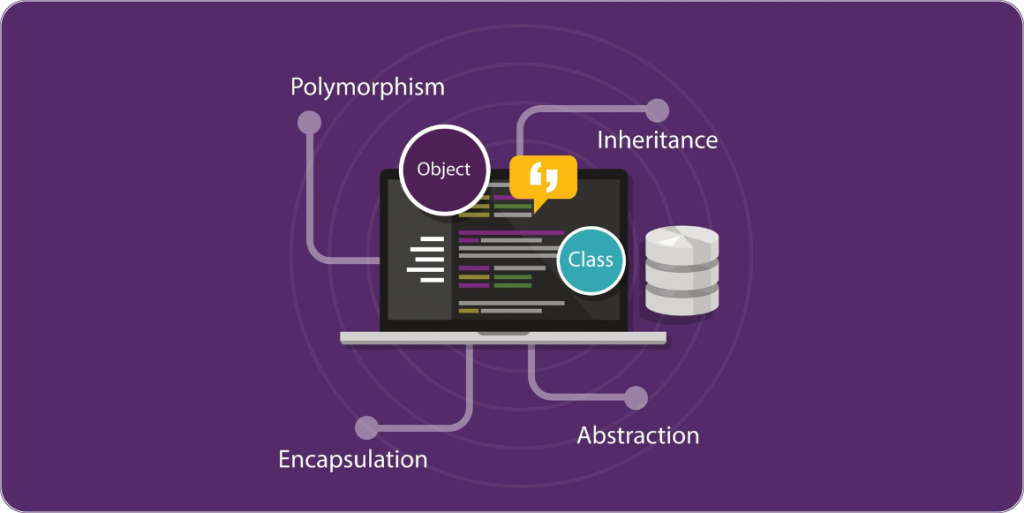Object-oriented programming (OOP) is a common way of writing code used by many developers. It’s a popular approach for building software and is usually taught to programmers during their academic studies. Another well-known way of programming is functional programming, but we won’t discuss that now.
Today, we’ll explore the fundamental aspects of making a program object-oriented. This will help you use this approach in your coding, projects, and discussions.
What is Object Oriented Programming (OOP)?
Object-oriented programming (OOP) is a way of designing computer programs where we focus on data or objects rather than just functions and logic. Each object contains specific characteristics and actions that make it unique.
In OOP, the main focus is on the objects that programmers want to work with, not just the steps to work on them. This way of programming is great for large, complex programs that need frequent updates. It’s widely used in various fields like manufacturing, design, and mobile app development, such as in creating simulation software for manufacturing systems.
Object-oriented programming helps in collaborative development by organizing programs into groups. It also brings advantages like reusing code, making programs scalable, and improving efficiency.
The initial phase involves gathering the objects you want to work with and figuring out how they connect to each other. This process is called data modeling.
Objects in object-oriented programming can be various things, like a person with a name and address or even small computer programs like widgets.
After identifying an object, it is associated with a class, which defines the data it holds and the actions it can perform. These actions are called methods. Objects communicate with each other through well-defined messages.
Building Blocks of OOP
The fundamental elements of object-oriented programming are as follows:
Class
Classes are custom or user-defined data types that outline how individual objects should be made, including their characteristics and actions.
Objects
Objects are created based on a class with specific data and characteristics. These objects can represent real things or abstract concepts. When a class is defined, only the description of the object is created initially.
Methods
Methods are like functions within a class that define how objects behave. Each method starts with a reference to the object it belongs to. These methods are called instance methods. Programmers use methods to reuse code and keep the functionalities inside an object separate and organized.
Attributes
Attributes are characteristics defined in a class blueprint that show the condition of an object. Objects hold information in these attributes. Class attributes are specific to the class they belong to.
Four Main Principles of OOP
Object-oriented programming has four main principles:
1. Inheritance: Child classes inherit data and behaviour from their parent class.
2. Encapsulation: Objects hold information privately, revealing only what’s necessary.
3. Abstraction: Objects offer simplified methods for interacting with them.
4. Polymorphism: Different methods can perform a similar task.

1. Inheritance
Classes can reuse code from other classes. Objects can be related and organized in a hierarchy, allowing developers to reuse common functionalities while maintaining uniqueness. This characteristic of OOP encourages detailed data analysis, saves development time, and ensures better accuracy in programming.
2. Encapsulation
This principle keeps vital details within an object; only specific information is shared. Each object’s workings and status are kept private within its designated class. Other objects can’t directly access this class or modify it. They can only use a set of public functions or methods. This concept of hiding data enhances program security and prevents accidental data errors.
3. Abstraction
Objects expose only the necessary inner workings to other objects, hiding unnecessary details. The derived class can build on the functionality of the base class, allowing developers to easily make changes or add new features as needed. This concept promotes code flexibility and facilitates future updates or modifications.
4. Polymorphism
Objects can share behaviors and can be flexible by taking different forms. The program decides which meaning or usage is required for each object during execution, reducing the need for repetitive code. By creating a child class that extends the parent class, polymorphism enables different types of objects to use the same interface.
Examples of OOP Languages
Simula is known as the first object-oriented programming language, but today, many languages use OOP. Some languages fully embrace OOP, treating everything as objects. Others are designed primarily for OOP but may include some procedural elements.
Examples of pure OOP languages are Ruby, Scala, JADE, and Emerald.
Languages like Java, Python, and C++ are designed mainly for OOP but have procedural features.
Other languages like Visual Basic .NET, PHP, and JavaScript also work well with OOP.
Object-Oriented Programming (OOP) Concept Example in Java
// Define a class named 'Car'
class Car {
// Attributes or properties of the Car class
String brand;
String model;
int year;
// Method to display car information
void displayInfo() {
System.out.println("Brand: " + brand);
System.out.println("Model: " + model);
System.out.println("Year: " + year);
}
}
// Main class
public class OOPExample {
public static void main(String[] args) {
// Create an instance of the 'Car' class
Car myCar = new Car();
// Assign values to the attributes of the 'myCar' object
myCar.brand = "Toyota";
myCar.model = "Corolla";
myCar.year = 2022;
// Call the 'displayInfo' method to show car information
System.out.println("My Car:");
myCar.displayInfo();
}
}
In the above program,
- Class: The program defines a class named
Car, which serves as a blueprint for creating car objects. The class encapsulates the attributes (brand, model, year) and methodsdisplayInfothat define a car.
- Object Creation: The program creates an instance of the
Carclass namedmyCar. This instance represents a specific car with its own set of attributes.
- Attributes: The class
Carhas attributes (brand, model, year) that define the state of a car. These attributes store specific information about each car object.
- Method: The class
Carcontains a method calleddisplayInfo, which is responsible for displaying the car’s attributes. This method allows the program to perform actions related to the car object.
Benefits of Object Oriented Programming (OOP)
Benefits of object-oriented programming (OOP) include:
- Easy to Understand and Work Together: OOP makes it simpler to work in teams as objects can manage their own data and tasks. This makes it easier to find and fix problems.
- Reusing Code: OOP allows you to reuse existing code, saving time and effort. You can use parts of existing objects to create new ones, so you don’t have to start from scratch.
- Faster Development: With libraries and pre-made code, programmers can build new programs more quickly and efficiently.
- Easy to Update and Expand: OOP lets you add new features without changing existing code. This makes programs easily upgradable and able to grow as needed.
- Clear Communication: Objects can send messages to each other, making it simple to describe how different parts of a system work together.
- Improved Security: OOP hides complex details, making it easier to protect sensitive information and maintain software over time.
- Adaptability: OOP allows functions to be used in different situations, and different objects can use the same tools. This makes programs more flexible and adaptable.
Conclusion
Object-oriented programming involves designing the program’s structure and creating a plan before writing code.
In computer programming, OOP is about dividing tasks into basic, reusable classes that serve as blueprints for creating objects.
This approach improves data organization and reusability, saving time and effort.
